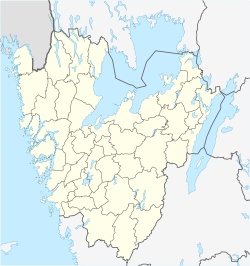Falköping
| Falköping | ||
|---|---|---|

Trätorget (17 June 2006)
|
||
|
||
| Coordinates: 58°10′30″N 13°33′11″E / 58.17500°N 13.55306°ECoordinates: 58°10′30″N 13°33′11″E / 58.17500°N 13.55306°E | ||
| Country | Sweden | |
| Province | Västergötland | |
| County | Västra Götaland County | |
| Municipality | Falköping Municipality | |
| Founded | 1200 | |
| Area | ||
| • Total | 8.54 km2 (3.30 sq mi) | |
| Elevation | 218 m (715 ft) | |
| Population (31 December 2010) | ||
| • Total | 16,350 | |
| • Density | 1,915/km2 (4,960/sq mi) | |
| Time zone | CET (UTC+1) | |
| • Summer (DST) | CEST (UTC+2) | |
| Postal code | 521 xx | |
| Area code(s) | (+46) 515 | |
| Climate | Dfb | |
| Website | Official website | |
Falköping is a locality and the seat of Falköping Municipality, Västra Götaland County, Sweden. It had 16,350 inhabitants in 2010.
The town of Falköping was first spoken of in the Icelandic Rimbegla (around 1100 A.D.), and is mentioned in the Westrogothic law. It was also an important site of pilgrimage due to its 12th-century church dedicated to Saint Olaf (Sankt Olof). The town was heading for a shut-down during the 16th century and was even burnt to the ground by the Danish during the Northern Seven Years' War. However the town survived and was rebuilt.
Falköping or Falbygden (when meaning the agricultural landscape in which Falköping is located) is widely known for its ancient remains of Stone Age, Bronze Age and Iron Age. The town is located between the two plateaus Mösseberg and Ålleberg. The location has been inhabited since the end of the ice age and cultivated by people for the last 6000 years. The oldest find is a form of megalitic tomb called dolmen, dating back to 3400 B.C. But there is also 28 passage graves dating back to 3300 B.C. Also several cists have been found here, they can be traced back to earlier Stone Age (Senneolitikum) 2400–1500 B.C and are believed to be built or inspired by travelers from England or other countries where these kind of graves were constructed. Falköping is the only town in Europe with this amount of megalithic graves as visible contribution to the town image. They can be found in parks, crossings, and even in the backyards of homes.
Early industry in Falköping was the Victoria Brewery (sv. Victoriabryggeriet) (1856–1953), Haglunds Roller blinds factory (sv. Haglunds rullgardinsfabrik) (1885-) and Forss hat factory (sv. Forss hattfabrik) (1880–). In the early 20th-century (1900–) several companies were established, such as: Alton gold forgery (1928), Falköping dairy factory (sv. Falköpings Mejeri) (1930–), workshop industry Arkivator (sv. verkstadsindustrin Arkivator) (1940–) and the sewing factories Svaréns and Ottossons.
...
Wikipedia



